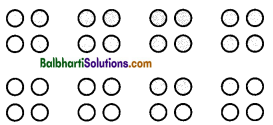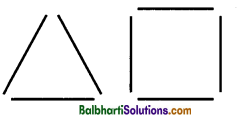By going through these Maharashtra State Board Class 12 Psychology Notes Chapter 4 Cognitive Processes students can recall all the concepts quickly.
Maharashtra State Board Class 12 Psychology Notes Chapter 4 Cognitive Processes
Introduction:
Cognitive processes are those processes by which we become aware of and understand the world around us. It includes processes like sensation, attention, perception, learning, memory, thinking, reasoning, problem-solving, etc.
Attention:
Attention is the selective process by which we focus on only a few stimuli from among the various stimuli that are present in our environment.
According to Norman Munn, “Attention is the mental process of bringing few stimuli into the centre of awareness out of the many stimuli present”.
Attention is influenced by objective factors such as intensity, size, movement, etc., of stimuli as well as subjective factors like interest, mindset, etc.
Aspects Of Attention:
Span of attention – It is the total number of stimuli that we can become clearly aware of in a single glance. Span of attention is limited, i.e., 7 to 8 items only. Factors like age, intelligence, motivation, practice, etc., affect the span of attention.
Distraction of attention – The drifting of attention from a specific stimulus to another stimulus is called distraction of attention. This is due to external factors such as intensity, novelty, movement, etc., of stimuli or internal factors like physical state, lack of interest, mental set, etc.
Division of attention – It is not possible to divide attention to two tasks simultaneously. We can perform two tasks at the same time only if both tasks are too simple or mechanical. If we try to pay attention to two tasks at the same time it may result in decreased efficiency and more confusion.
Fluctuation of attention – It is difficult to attend to a single stimulus for a long period of time. Our attention may shift from the original stimulus to another stimulus for a fraction of time and then comes back to the original stimulus. This may be due to factors like fatigue, decreased interest, etc.
![]()
Perception:
Perception = the sensation + assigning meaning to the sensation. In understanding our world, sensation occurs first, followed by attention and finally perception of stimuli based on past experience. Perception is defined as “the process of assigning meaning to information received about the environment based on the past experiences.”
Phenomena associated with Perception:
Top-down processing and Bottom-up processing – When we utilize top-down processing, our ability to understand information is influenced by the context in which it appears. Bottom-up processing is a process that starts with an incoming stimulus and works upwards until a representation of the object is formed in our brain.
Laws of perceptual organization – Our brain has the tendency to organize our sensations as a meaningful whole. Max Wertheimer first explained this tendency in the form of laws of perceptual organization.
Some laws of perceptual organization are as follows:
Law of proximity – Stimuli that are near to each other are perceived as together, rather
than stimuli that are far away from each other.

In the above figure, we perceive pairs of dots in each line because the dots which are near to each other are perceived together. So instead of perceiving a line of 8 dots, generally a line of four pairs of dots is perceived.
Law of similarity – Stimuli that are similar to each other are perceived together than stimuli that are distinct from each other.

In the above figure, we perceive 4 alternate vertical lines each of circles and crosses as similar stimuli are perceived together. Generally, we do not perceive 4 horizontal lines each having circles and crosses in alternate sequence.
Law of continuity – There is a tendency to perceive a stimulus in continuation according to its established direction.

In this figure, a straight vertical line and a straight horizontal line are perceived together as a letter ‘L’ and a cutting line is perceived separately as a line following the smoothest path. Generally, we do not perceive here four different lines going in different directions.
Law of closure – There is a tendency to fill in the gaps in an incomplete stimulus so as to perceive it as a meaningful figure.

In the above figure, we fill in the gaps and perceive it as a triangle and square. Generally, we do not perceive here the three or four separate lines going in different directions.
Thinking:
Thinking is the mental activity that uses various cognitive elements and processes that involves the manipulation of information.
The core elements of thinking are –
- Mental representation – It is a coded internal sensation that is acquired by direct experiences through the sense organs or by indirect experiences such as narrations, pictures, etc.
- Concepts – They form the basis for all cognitive processes, acting as building blocks by connecting with each other to form more complex concepts.
- Schema – It is an internal representation that organizes knowledge about related concepts and relationships among them.
- Language – Mental representations, concept and schema are represented by language, for e.g., the word ‘cat’ is a symbol for a ‘cat’.
![]()
Types Of Thinking:
Problem Solving:
Problem-solving is a type of thinking, i.e., the process of finding solutions to problems encountered
in life.
It includes the following steps.
- Defining the problem – We need to identify and define the problem correctly.
- Generating alternative solutions – The person searches for possible solutions to the problem.
- Selecting a solution – The person selects what he considers to be the most effective solution.
- Implementing the solution and follow up on the solution – The person tries out the selected solution and evaluates the outcome i.e. whether it has helped to solve the problem.
Creative Thinking:
Creative thinking is characterised by the ability to perceive the world in new ways, to find hidden
patterns, etc.
The four stages in creative thinking are –
- Preparation – It involves formulating the problem and gathering information about it.
- Incubation – If the person does not get the required results, he/she may focus on things unrelated to that problem. The period helps to work out the problem without consciously thinking about it.
- Illumination – After incubation, suddenly the correct solution appears to the person, due to which he/she experiences excitement.
- Verification – The new solution may sometimes need to be evaluated again and again.
Learning:
Learning is defined as “a relatively permanent change in behaviour that occurs due to experience
or practice”.
The characteristics of learning are :
- It involves some relatively permanent change in behaviour.
- The change in behaviour is due to experience or practice.
- Change in behaviour may be in knowledge, e.g. a new concept, or in skills, e.g. learning to ride a cycle, or in muscular movements.
- Learning is an inferred process.
Processes of Learning:
Learning by Classical Conditioning:
Classical conditioning was first explained by Ivan Pavlov. It is learning by forming associations and by stimulus substitution. In daily life, we learn many things this way, for e.g., a child is given an injection by the doctor and begins to cry in pain. He soon makes the connection between ‘doctor’, ‘injection’ and ‘pain’ and begins crying as soon as he is taken to a doctor.
Learning by Operant Conditioning:
Learning by operant conditioning was first explained by B. F. Skinner. He said that learning takes place to gain positive consequences or to avoid negative consequences.
Learning by Cognitive Processes:
Edward Tolman explained that learning may take place using cognitive processes like problem-solving, reasoning, etc., and not only due to forming of connections (as explained by classical conditioning) or due to the consequences of behaviour (as explained by classical conditioning).
Learning by assimilation and accommodation:
Jean Piaget explains that we learn by forming and refining our concepts on the basis of ‘ similarities and differences between new and existing information.
Learning by observation:
According to Albert Bandura, we learn by observation, imitation of the behaviour of others, etc. This occurs in respect to skills, for e.g., eating with a fork/spoon as well as in our thinking, decision making, etc.
Glossary:
→ Attention – Sustained concentration on specific stimulus.
→ Concept – A mental representation or idea that represents a category.
→ Learning – The ability to acquire knowledge or skills, or any relatively permanent changes in one’s behaviour as a result of experience or practice.
→ Mental Representation – An internal representation of information.
→ Perception – The process by which we recognise, organise and interpret of sensory information.
→ Schema – An organised framework of knowledge based on past experiences and memory and helps in perception and interpretation of new information in terms of existing knowledge.
→ Thinking – It is a cognitive process which involves mental representation and manipulation of information.